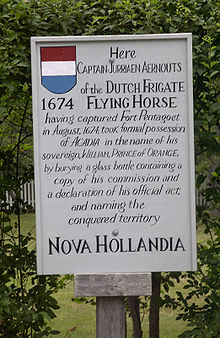- Dutch occupation of Acadia
-
The spot where Jurriaen Aernoutsz buried a bottle at Fort Pentagouet, Castine, Maine marking the Dutch claim over Acadia

The Dutch Occupation of Acadia began when the Dutch naval captain Jurriaen Aernoutsz seized several settlements of Acadia, a part of the French colonial empire in northeastern North America, in 1674. Areas briefly occupied included coastal towns along the shores of Maine and New Brunswick, two forts, and a French military headquarters. Effective control of the territory was never fully established. The French regained control of the area in 1675, and the formal Dutch claim to Acadia (1676) was finally abandoned with the Treaty of Nijmegen in 1678.
Contents
History
In 1672 the Franco-Dutch War began, and England allied itself with the French. England and the Netherlands came to terms early in 1674, several months before the July day when Captain Jurriaen Aernoutsz sailed into New York harbor. Previously he had been sailing the North Atlantic Ocean looking for English and French ships to attack.[1]
In New York he met a trader named John Rhoades, a Massachusetts resident thoroughly familiar with the fur trade on the coasts of Maine and Acadia, who told him that the Dutch were no longer at war with the English, but that France had yet to come to terms. Rhoades went on to explain to Aernoutsz that the French colony in Acadia was barely defended and ripe for conquest. Aernoutsz took this suggestion to his a crew and they agreed unanimously.[2] John Rhoades would be the crew's guide.
Aernoutsz immediately set sail for Fort Pentagouet in Penobscot Bay (present day Castine, Maine). There were only 30 French soldiers in the fort and they were lightly armed. The Dutchmen took the fort easily. While they were there they also took the French Military Headquarters. Following this, they sailed to Jemseg and captured another French fort there. At both places, Aernoutsz buried bottles at Fort Pentagouet with messages inside them proclaiming that "Acadie" was to be Dutch possession and henceforward known as Nova Hollandia ("New Holland").[3] The commander of the Forts, Jacques de Chambly, was taken prisoner by the Dutch at this time.[4]
Aernoutsz sailed to Boston where he disposed of his plunder, even selling the cannon from Fort Pentagouet to the Massachusetts government. Some time in October 1674 he sailed for Curaçao, but left his prisoners and a number of his company in Boston, including John Rhoades.[5]
Aernoutsz’s efforts were soon negated by the action of Massachusetts. John Rhoades and the other men Aernoutsz had left in Boston, acting under Aernoutsz's orders to return to Acadia and maintain possession, began seizing New England vessels coming to trade with the Native Americans. Massachusetts apprehended Rhoades and his cohorts and tried them as pirates. Ultimately they were all released or banished from Massachusetts.[5][6][7]
Aftermath
In September 1676 the Dutch West India Company made a belated effort to capitalize on Aernoutsz’s conquest by granting Rhoades a commission to reside and trade in Acadia and by appointing Cornelis van Steenwijck, a Dutch merchant in New York, governor of the "coasts and countries of Nova Scotia and Acadie."[8]
Although the territory was claimed by the Dutch, they had no real power over the area. Later in 1676, the two forts were reoccupied by the French.[8] The dispute over the colony was resolved by the Treaty of Nijmegen in 1678, in which the Dutch withdrew their claim to the colony. The treaty, which did not mention the claim specifically, also ended the Franco-Dutch War.[5][8]
References
- ^ The Pirates of the New England Coast, 1630-1730. George Francis Dow, John Henry, pg. 44.
- ^ John G. Reid. Acadia, Maine, and New Scotland: Marginal Colonies in the Seventeenth Century, pg. 162.
- ^ John G. Reid. Acadia, Maine, and New Scotland: Marginal Colonies in the Seventeenth Century, pg 171.
- ^ Mary Beacock Fryer. Battlefields of Canada, pg. 246.
- ^ a b c "Rhoades, John", Dictionary of Canadian Biography Online.
- ^ "Aernoutsz, Jurriaen", Dictionary of Canadian Biography Online.
- ^ Ramerini, Marco. "The Dutch Settlements in North America".
- ^ a b c Francis Champernowne: The Dutch Conquest of Acadie and Other Historical Papers, edited by Charles W. Tuttle and Albert H. Hoyt. ISBN 0788416952.
Dutch Empire Colonies and trading posts of the Dutch East India Company (1602-1798) GovernoratesAmbon · Banda · Batavia · Cape Colony · Ceylon · Coromandel · Formosa · Northeast coast of Java · Makassar · Malacca · MoluccasDirectoratesCommandmentsResidenciesColonies and trading posts of the Dutch West India Company (1621-1792) Colonies in the AmericasAcadia · Berbice† · Cayenne · Curaçao and Dependencies · Demerara · Essequibo · Brazil · New Netherland · Pomeroon · Sint Eustatius and Dependencies · Suriname‡ · Tobago · Virgin IslandsTrading posts in Africa† Governed by the Society of Berbice · ‡ Governed by the Society of Suriname Settlements of the Noordsche Compagnie (1614-1642) SettlementsColonies of the Kingdom of the Netherlands (1815-1962) Until 1825Until 1853Until 1872Until 1945Until 1954Until 1962† Became constituent countries of the Kingdom of the Netherlands; Suriname gained full independence in 1975, Curaçao and Dependencies was renamed to the Netherlands Antilles, which was eventually dissolved in 2010. Kingdom of the Netherlands (1954-Present) Constituent countriesCategories:- Dutch colonization of the Americas
- Colonial United States (Dutch)
- Pre-state history of Maine
- Conflicts in Nova Scotia
- History of Nova Scotia
- Acadian history
Wikimedia Foundation. 2010.

